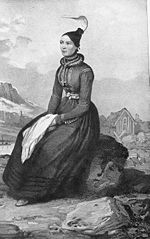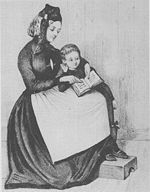
Buningurinn
Encyclopedia

Iceland
Iceland , described as the Republic of Iceland, is a Nordic and European island country in the North Atlantic Ocean, on the Mid-Atlantic Ridge. Iceland also refers to the main island of the country, which contains almost all the population and almost all the land area. The country has a population...
ic national costume
National costume
Folk costume expresses an identity through costume which usually to a geographic area or a period of time in history, but can also indicate social, marital and/or religious status...
s. The national costume has enjoyed various levels of popularity since the term was coined in Iceland in the 19th century, during the fight for independence. Since 2001 the national costume is regulated by Þjóðbúningaráð (The National Costume Authority), which preserves the correct techniques of making them and instructs people.
Women's costume
The five following types of costume are all recognized as Icelandic National costumes. However both the kyrtill and skautbúningur were designed in the 18th century from scratch as ceremonial costumes, while the faldbúningur, peysuföt and the upphlutur are traditional daily wear of Icelandic women in olden times.Faldbúningur

Ruff (clothing)
A ruff is an item of clothing worn in Western Europe from the mid-sixteenth century to the mid-seventeenth century.The ruff, which was worn by men, women and children, evolved from the small fabric ruffle at the drawstring neck of the shirt or chemise...
which is the reason for the faldbúningurs wide collar, which was designed to support it. Later, around the turn of the 18th century women started to wear the much simpler tail-cap with it.
Peysuföt

Icelandic tail-cap
The Icelandic tail-cap or skotthúfa is a typical part of the Icelandic national costume. Originally it was only worn by men, but starting in the 18th century women started to wear it along with the peysa, a men's jacket with a single row of buttons creating the proto-peysuföt...
. It is believed that this costume was invented when women, desiring simpler working clothes than the faldbúningur, started to use male articles of clothing. This includes both the tail-cap and the peysa which originally was a jacket with a single row of buttons, but evolved into this costume and eventually discarded with the buttons.
Upphlutur
The Upphlutur is a woman's costume, consisting of bodice that can be coloured in bright colours such as red or blue, but often black. Its headpiece is a tail capIcelandic tail-cap
The Icelandic tail-cap or skotthúfa is a typical part of the Icelandic national costume. Originally it was only worn by men, but starting in the 18th century women started to wear it along with the peysa, a men's jacket with a single row of buttons creating the proto-peysuföt...
. The costume is basically the undergarment of the faldbúningur which evolved into a costume of its own right.
Kyrtill
The Kyrtill is a costume for women, designed by the artist Sigurður Guðmundsson in the 19th century. It was designed to look like VikingViking
The term Viking is customarily used to refer to the Norse explorers, warriors, merchants, and pirates who raided, traded, explored and settled in wide areas of Europe, Asia and the North Atlantic islands from the late 8th to the mid-11th century.These Norsemen used their famed longships to...
-age costumes. It however incorporates a hat similar to the one on the skautbúningur. While Sigurður's vision of the Viking age costume remains popular, costumes designed to more closely resemble archaeological finds have gained some popularity as well.
Skautbúningur
The Skautbúningur was also designed by Sigurður Guðmundsson. It was conceived as a modernized variation of the faldbúningur, which had fallen out of use by the middle of the 19th century. It incorporates a complicated hat inspired by the ones traditionally used with the faldbúningur.Men's costume
Búningur karla or the Mens costume exists in three or four radically different versions. The þjóðbúningur karla is the only direct descendant of traditional daily wear of Icelandic men, while the other were designed from the start as ceremonial costume.Þjóðbúningur karla
The one considered most traditional consists of woolen breeches or trousers, a usually double buttoned vest and a double buttoned jacket called treyja. Sometimes a peysa with a single row of buttons is used in lieu of the vest and treyja. On the head is a tail capIcelandic tail-cap
The Icelandic tail-cap or skotthúfa is a typical part of the Icelandic national costume. Originally it was only worn by men, but starting in the 18th century women started to wear it along with the peysa, a men's jacket with a single row of buttons creating the proto-peysuföt...
, though historically different hats were also used. This costume was usually black, navy blue or dark green, although the vest, which was usually brighter was sometimes red, some regions stood out, using white wool instead of the darker colors. It is identical to the clothing Icelandic men commonly wore from the 17th until the 19th century.
Fornmannaklæði
In the middle of the 19th century, when many Icelandic men had taken to using continental clothing, Sigurður Guðmundsson, an Icelandic artist, designed a costume for men which closely resembles 10th century Nordic clothing. While it attained some popularity at the time, it eventually disappeared until at the end of the 20th century when VikingViking
The term Viking is customarily used to refer to the Norse explorers, warriors, merchants, and pirates who raided, traded, explored and settled in wide areas of Europe, Asia and the North Atlantic islands from the late 8th to the mid-11th century.These Norsemen used their famed longships to...
culture and traditions have enjoyed increased popularity.
Hátíðarbúningur
Although not a traditional costume, the hátíðarbúningur was conceived as a modernized version of the men's traditional national costume and is frequently worn instead of a tuxedoTuxedo
A tuxedo is a type of semi-formal dress for men.Tuxedo may also refer to:-Places:Canada* Tuxedo, Winnipeg, Manitoba, a city neighborhood** Tuxedo , a provincial electoral district in Manitoba...
to formal events. It is the result of a competition for an updated (i.e., more pragmatic) version of the men's national costume held in 1994 in correlation with the 50th anniversary of Iceland's independence from Denmark
Denmark
Denmark is a Scandinavian country in Northern Europe. The countries of Denmark and Greenland, as well as the Faroe Islands, constitute the Kingdom of Denmark . It is the southernmost of the Nordic countries, southwest of Sweden and south of Norway, and bordered to the south by Germany. Denmark...
and the establishment of the republic
Republic
A republic is a form of government in which the people, or some significant portion of them, have supreme control over the government and where offices of state are elected or chosen by elected people. In modern times, a common simplified definition of a republic is a government where the head of...
. Some have critiqued the design of the hátíðarbúningur, claiming that it bears greater resemblece to the Faroese
Faroe Islands
The Faroe Islands are an island group situated between the Norwegian Sea and the North Atlantic Ocean, approximately halfway between Scotland and Iceland. The Faroe Islands are a self-governing territory within the Kingdom of Denmark, along with Denmark proper and Greenland...
national costume in its styling. Regardless, the hátíðarbúningur continues to enjoy widespread popularity among Icelanders.
The fourth costume
Sigurður Guðmundsson also designed another costume in the middle of the 19th century, which was commonly worn by students. It consisted of a black jacket, white shirt and black knee-breeches with horizontally striped or solid colored white socks.Children's costumes
The búningur barna or the children's costumes did not differ from the adult's version (except in size) until the 20th century, when girls were given shorter skirts.Shoes
Although today, modern shoes are often used with the National Costumes, traditionally shoes made of either fish or sheep-skin, with woolen inlets, were worn with the costumes. These shoes are known as roðskór and sauðskinsskór respectively. Some people also use 18th or 19th century type leather shoes with buckles similar to the footwear commonly used with the Faroese and Norwegian National Costumes.Usage
In olden times these clothes, except the skautbúningur, kyrtill and hátíðarbúningur, were worn daily by people of all ages and classes. Today they are worn by many on ceremonial occasions such as the National day, Birthdays and Weddings.Links and Sources
- Buningurinn.is - Official Website of Þjóðbúningaráð, The National Costume Authority
- Upphlutur.is - Website of the Þjóðbúningastofan, National Costume house
- BB.is - 3 Pictures of Icelandic National Costumes

